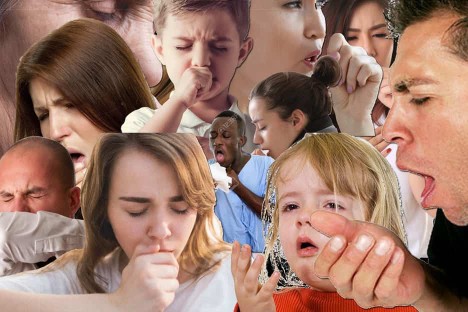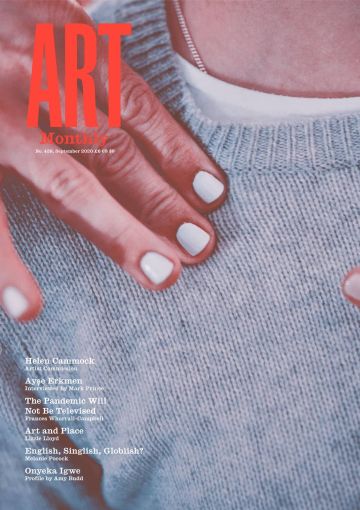Report
Online Round-up
Lauren Velvick on the variety of approaches, from browser plug-ins to web interruptions, that artists and organisations are using to present art online

Matthew de Kersaint Giraudeau, Coughing, 2020, part of ‘Lan Gwuhj Geimz’ on the Open School East website
In a 2018 interview about Glitch Feminism – now a book released by Verso this month – Legacy Russell dismisses ‘digital dualism’ and encourages an understanding of the looping continuity between online and offline experience: ‘I take issue’, Russell states, ‘with this idea of “IRL” because it seems to suggest that things happening online are somehow not “real” – this idea of “real” is flawed.’ After first encountering Russell’s thinking in ‘Wandering/Wilding: Blackness on the Internet’ at London’s IMT Gallery in 2016, her conception of the glitch as a widely applicable site of possibility has been useful in considering online exhibitions and artworks, particularly from within conditions of crisis and widespread civil unrest. From the perspective of a lucky stay-at-home worker, the viewing of online art takes place as part of an almost entirely screen-based daily routine, and artworks are either purposefully sought out or delivered by recommendation and idle clicking. From a vast field, the few examples discussed here offer disparate avenues for access and engagement, but avoid attempts at replicating the offline viewing experience, and are often able to slot within the rhythm of time spent waiting for pages to load and files to upload. For example, with Arebyte gallery’s ‘Real Time Constraints’, the pop-ups that present each artwork to the viewer via a browser plugin appear at intervals throughout the hours of a standard working day.
When artworks are delivered directly to your laptop screen, it is tempting to focus on the comparative ease of access, but a sense of continuity and vacillation between online and offline spaces is also present with these exhibition systems. In a panel discussion between several of the artists featured in ‘Real Time Constraints’ the participants grappled with their responsibility as artists working with influential and oft-misunderstood technologies. This group had been brought together in order to ‘look critically at the current state of automated and autonomic computing’, and while some works initially seem more concerned with evoking wonder, the resulting contrast between these and the more overtly critical works is effective. Gretchen Andrew’s The Next American President and Ben Grosser’s Tracing You both clearly evoke the ominous aspects of the technologies they employ; during the panel on which both spoke, a discussion arose around the usefulness and credibility of personifying technological systems, and projecting intentions on to their programming. Is it a helpful mental shorthand or a simple misapprehension to think of technological systems as ‘wanting’ entities? Andrew emphasised the fact that computers cannot ‘have’ or ‘want’. On her website, the artist explains that the internet cannot parse desire, and so, in her view, it is a space in which desires can be manifested. Grosser, conversely, finds it practical to conceive of computers as ‘wanting’ data, on the grounds that ‘we are embedded within systems and digital spaces that are designed to elicit engagement’. The insidious, addictive and manipulative nature of the systems and platforms that many of us use on a daily basis has been discussed widely, but is worth continued attention as the near-constant online interface becomes inescapable for many.
In the accompanying interpretation for ‘Real Time Constraints’, Rebecca Edwards (co-curator with Luba Elliott) characterises the exhibition’s pop-ups as ‘stopping cues’, going on to explain that ‘the way we consume media today is such that there are no stopping cues, there is no design in place that allows us to question our behaviour’. Producing the circumstances for a viewer to temporarily depart from the coercive flow of their online experience, whether by interruption or invitation, seems to be a shared aim. Of ‘Lan Gwuhj Geimz’, his intervention on the new Open School East website, curator and artist Matthew de Kersaint Giraudeau spoke about exploring an antagonistic relationship with the attention economy of the internet, with which an artwork can rarely compete. Having been commissioned at the same time that the new website was being designed, Giraudeau worked with coder Rob Smith and drew on his own prior interest in broadcasting, gesture and affect to display works developed in collaboration with OSE associates. Appearing at random on each page, these commissions interrupted the viewer like the adverts on a local news site, sometimes all but obscuring the page behind. The frequency of the artworks’ appearance, however, could be controlled by a slider that allowed the viewer to choose how often they would like to be – or could stand to be – interrupted. An acknowledgment of the project’s own potential undesirability was built into its display, evoking the melancholy plight of both online artworks and their material counterparts, which are created to be viewed but may never command that attention.
Distinct from these methods of online presentation that seem to creep through, haunt and confuse a smooth engagement with the internet, there are other artworks that refuse, and even counteract, an attention economy predicated on biased datasets and discriminatory algorithms. In Shape Arts’ ‘The Future is Loading (Part 1)’ works are presented straightforwardly with audio description and BSL interpretation, stating in the accompanying text that ‘for many disabled and marginalised people, familiar with adversity, witnessing the world come to a halt in a matter of days has paradoxically generated hope’. This succinctly expresses the difficult but necessary dichotomy that we are living with: this current situation may be hard, but the way things were before wasn’t good enough either and we should not seek a straightforward return to the prior status quo. Pages for A Body that needs them by Danielle Brathwaite-Shirley, one of the works in ‘The Future is Loading’, takes the form of a game that asks at different points for the viewer, or player, to state their identity and intentions. In expecting, rather than requesting, good-faith engagement and self-reflection, the future-oriented imagination as an ‘act of radical defiance’ spoken of in the exhibition text is evident. This expectation of honesty and a willingness to withstand decentring from a position of privilege is also present in Brathwaite-Shirley’s earlier game work, The Black Trans Archive, whereby the viewer is guided through a continuous, browser-based journey with numerous forking paths.
Engaging with these time-based works in their own tabs demands the eschewal of other distractions, each work claiming a position of importance through sincerity and emotional commitment, rather than the manipulation of SEO techniques or privacy intrusion. In terms of online curation, that doesn’t assume a one-to-one relation with the viewer; while the pop-ups of ‘Real Time Constraints’ may appear at the same time for everyone installing the exhibition plugin, live broadcast can allow viewers to react in real time and interact with each other. This not only creates a self-consciously communal moment online, but also enables the attendance of those who otherwise wouldn’t be present at art events that can be inaccessible for many reasons. An exhibition run by IMT between August and December, ‘This Is A Not-Me’, assumes this form, with artworks broadcast at intervals over the weeks and a curatorial rationale that leans into the drifting weirdness of this period wherein an inability to plan ahead means living in a perpetual present. In line with the alternating absurdity, anxiety and ennui of this state, the exhibition text cites Disney’s High School Musical as a curatorial framework, with the artists enacting an ironic artifice of joy and togetherness, while mourning in the knowledge that everything familiar is already over. Without needing to travel or cope with physical constraints, it is possible to ‘visit’ many of these exhibitions one after another or in between other tasks, and the opportunity to pivot between works that alternately expose the predation of our current systems, forge a path into the future or waver in the emotional reality of the present has become a habitual alternative to automatic scrolling.
Lauren Velvick is a writer and curator based in Lancashire.
First published in Art Monthly 439: September 2020.









